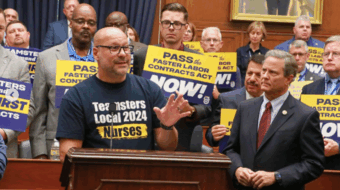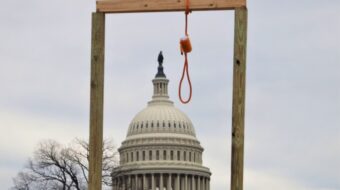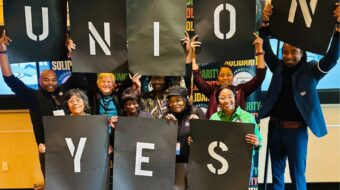Evidence that all the media hype about a coming GOP victory in the mid-term elections may be totally off base surfaced Oct. 12 in a warning to the ruling class from no better a spokesman for that class than the Wall Street Journal itself.
The WSJ ran an article with a picture of President Obama and AFL-CIO president Richard Trumka shaking hands before the start of an October meeting of the President’s Economic Recovery Advisory Board.
The article said Trumka had told reporters that unions are building a firewall to protect the Democrats’ House majority. Trumka “presented numbers,” the WSJ said, “suggesting the Republican mountain to climb to the majority is indeed a steep one.”
The “math” that Trumka presented, according to the WSJ, was math that should long have been obvious to the mainstream media and pollsters who have chosen, instead, to ignore it. After all, the real math gets in the way when you want to predict disaster for the president and the Democrats.
Trumka started by telling reporters that 75 Democratic House seats are in play. Nothing earth shattering there. Almost everyone agrees with that figure.
To become the majority party in the House Republicans need to net 39 seats. Again, no great analytical skill needed to come up with that figure.
Here’s where the analysis began to depart from what the pollsters have been looking at so far and here’s where the WSJ starts to get nervous:
Trumka apparently scared them by saying that of the 75 seats in play, 37 are “high union density” districts, districts the journal then said range from “the suburbs of Chicago to the hard-scrabble working regions of Pennsylvania.”
None of the pollsters deal with the issue of union density. Yet, in 2006 and even more so in 2008 union members, when they learned from direct contact with fellow union members who their union was endorsing, voted overwhelmingly for those candidates.
A majority of union members don’t yet know who their union is endorsing. A majority of the public still doesn’t know who is running for what office. Polls that predict any winner, therefore, even this close to the election, should not be taken literally.
By running a massive drive to inform union members about who labor is backing in the key districts, voters who might have been unlikely to vote or who might have voted for another candidate become, as each day passes, more voters who are now likely to vote and more voters who will back union candidates.
Obviously aware of this, the WSJ further notes in its warning that “if Democrats can take four Republican seats, as many analysts expect (GOP seats in Delaware, New Orleans, Hawaii and the northern suburbs of Chicago could swing), Republican candidates would need to win 59 percent of the Democratic seats up for grabs.” That, in itself, is a tall order, considering that Democrats took only 56 percent of the Republican seats in play in the 2006 tsunami that gave them the majority in the House.
The Wall Street journal warns that if Democrats can secure 60 percent of the “high union density” seats, Republicans would have to win 75 percent of the Democratic seats in play. Notwithstanding the fact that something like that has never happened before, such a GOP victory would seem unlikely.
The WSJ ends its article with what, for the journal, is a scary quote from Trumka: “Union voters are the firewall.”
Trumka visited a union phone bank in Chicago earlier this month at which he talked about the labor movement’s strategy. The idea, he said, is to contact every union member in those 37 high density districts by mailing, by phone, with leaflets and at the workplace. “When they know who to vote for, based on who is for their issues, they will vote for the union endorsed candidates,” he said at the time. History shows that this is what happened in 2006 and in 2008. “That’s why everything we do between now and Nov. 2 counts,” said Trumka. “The results on Nov. 2 are not pre-ordained. You folks (the union members calling their union brothers and sisters on the phones), not the corporations and all their money, are the ones who will make it happen.”










